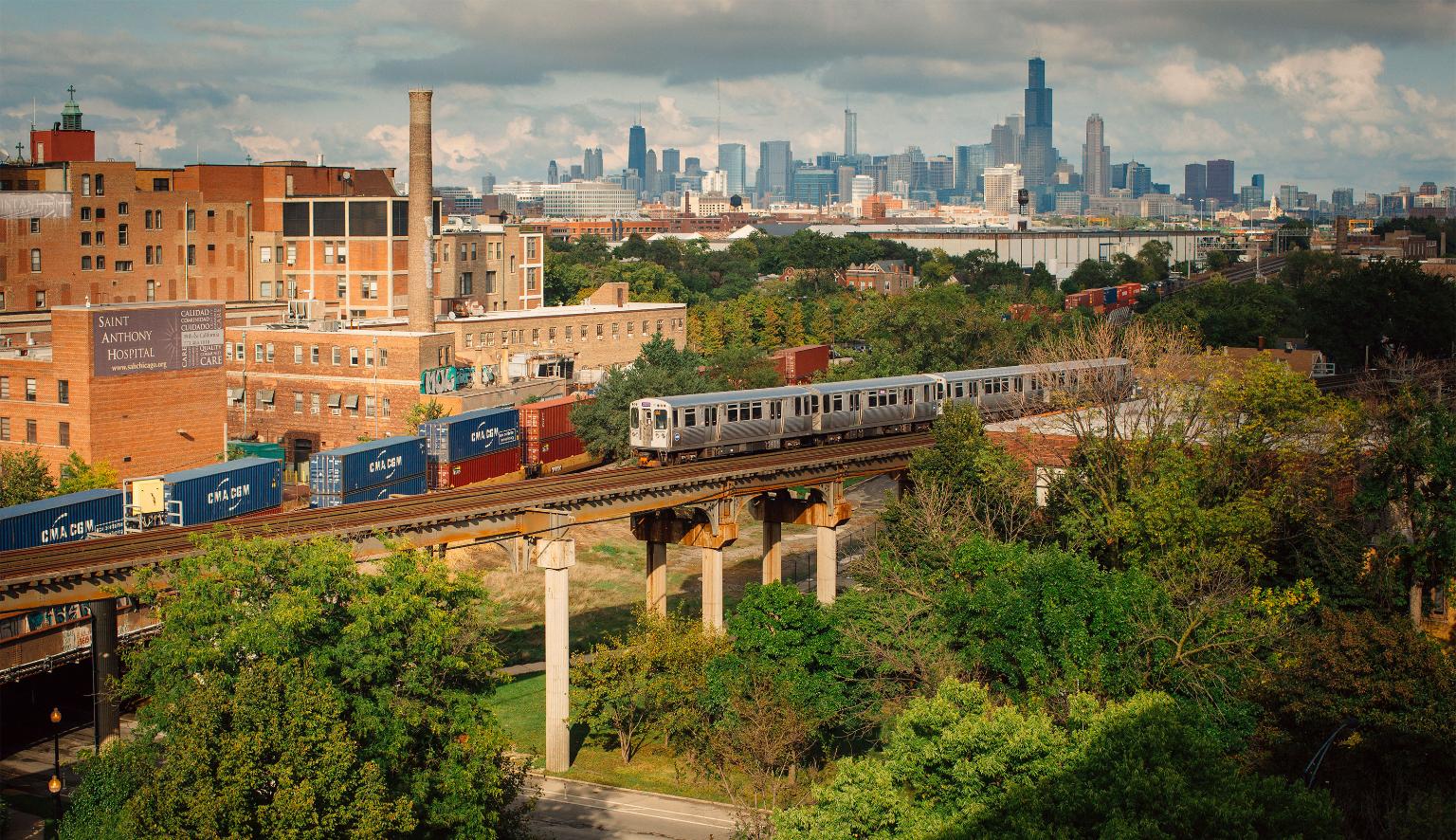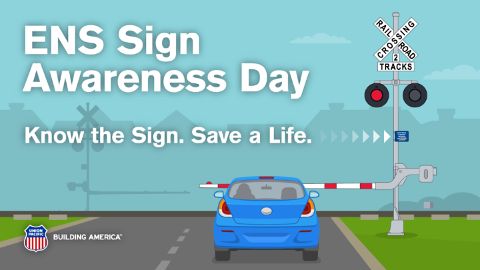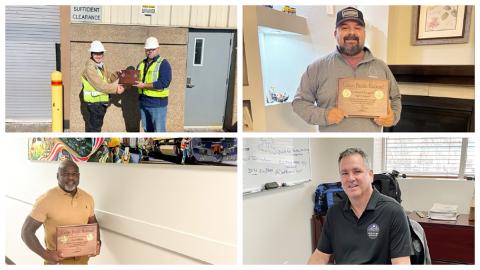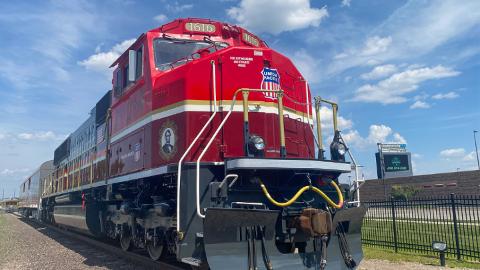In the pre-dawn drizzle of an early fall day, commuters in Evanston, Illinois, a suburb just north of Chicago, watch an inbound Metra train pull into the station at precisely 6:13 a.m. They line up where they know doors will most likely open and sort themselves out, some heading to the upper deck for the tree-top view.
As the passengers settle in with newspapers, books, laptops and cell phones, the train begins its journey on elevated track, passing over bridges built more than a century ago and winding through even older residential neighborhoods. For the next half hour, passengers glide above stores, restaurants and industrial districts, over the Chicago River, beneath the Lake Street "L" and finally through a canyon of towers sheathed in concrete and glass. The train slows to a gentle stop on one of 16 tracks covered by a teal-trimmed canopy at the Ogilvie Transportation Center in the heart of the city's thriving West Loop.
Moving More Than Freight
Union Pacific employees operate some Chicago Metra locomotives, transporting more than 100,000 people between Chicago and its outlying suburbs every day.
The passengers head toward the station, oblivious to the extraordinary effort that has gone into making their morning routine reliably routine. Most aren't aware they have just traveled through a small part of a vast network known among railroaders as the Chicago Terminal, through which a quarter of the nation’s freight also travels: more than 3 million freight cars annually.
Near mythic in size, complexity and history, the terminal laces together six counties sprawled across hundreds of square miles in the northern part of the state. Six of the nation’s seven Class 1 railroads, two “switcher” railroads, 11 commuter Metra lines (three run by Union Pacific) and, of course, maintenance crews, share track throughout the terminal.
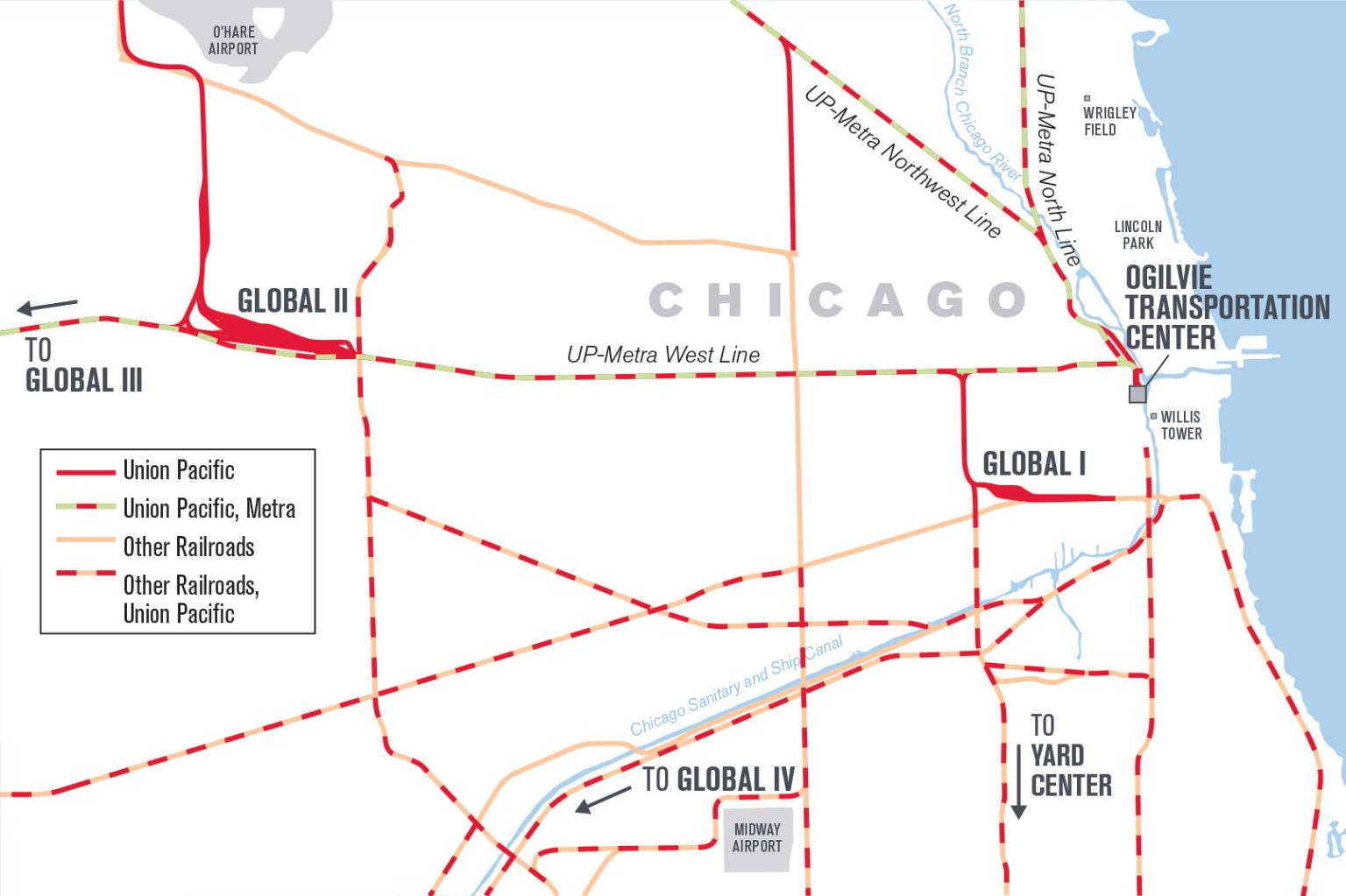
Chicago is the busiest freight rail hub in the U.S., handling more than 3 million freight cars annually.
Yet every day, hundreds of trains move tens of thousands of passengers and thousands of freight cars through the terminal, a feat as demanding as it is largely unseen.
Between rush hours, Metra trains retreat to train yards hidden beneath highway overpasses or behind embankments throughout the city. Freight trains that have been waiting in the wings, sometimes staged as far away as Iowa, begin to negotiate their journeys through the terminal. It is a process that Director Dave Grewe, working out of Union Pacific's Chicago Transportation Coordinator's Office, wryly calls a series of "Mother, may I's?"
"Because we don't control our own destiny, we have to get permission to enter onto each railroad's tracks," Grewe said. "For example, to get from our Proviso Yard to another yard in Chicago called Yard Center there's a 10-mile section of track where Union Pacific needs clearance from four other railroads: CSX, Norfolk Southern, Canadian National and the Belt Railway Company of Chicago."
Untangling the Mess
Chicago's advantage as the nation's central rail hub linking east and west coasts became a bottleneck as the city expanded, suburbs sprawled and the demands of commuters came into increasing conflict with the business of moving freight. Passage of the North American Free Trade Agreement (NAFTA) in 1994 elevated the terminal's role as a continental hub, connecting the U.S., Canada and Mexico. Because the railroads are so intertwined, and the amount of rail traffic passing through Chicago is so heavy, the 10-mile journey Grewe describes used to take hours. Thanks to an initiative called CREATE the trip now takes about 20 or 30 minutes.
CREATE, or the Chicago Region Environmental and Transportation Efficiency Program, brought all interested parties together to untangle the mess. The group eventually identified 70 projects to ease congestion. Since 2003, 28 have been completed and another 24 are underway, most notably:
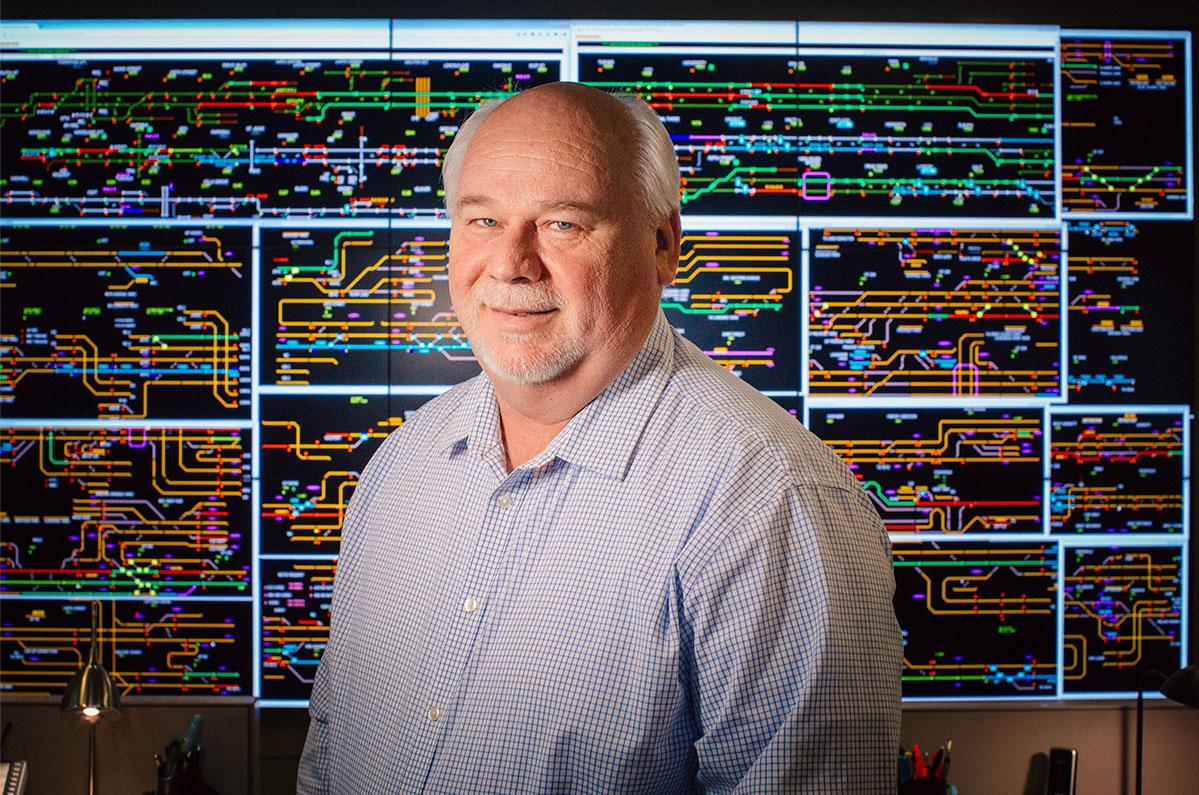
Dave Grewe is the director of the Union Pacific Chicago Transportation Coordination Office.
- Adding 3.5 miles of third main line track in the UP Geneva Subdivision
- Constructing a new flyover connecting the Indiana Harbor Belt, the largest switch railroad in the U.S., to the new third main line
- Building two new Metra passenger stations on the UP-West line at Berkeley and Bellwood, Illinois
- Eliminating the at-grade crossing at 25th Avenue in Bellwood, Illinois, with an overpass
Grewe has since assumed responsibility for all the procedures and processes the team follows to administer CREATE. "Everything, including funding, had to be agreed on by every partner," he said.
Having worked on the project for more than 13 years, Grewe is looking forward to seeing the other 19 projects through to completion. "It's kind of like your son," he said. "You'd like to see him grow up and graduate and eventually become a man. CREATE is a teenager now. We haven't quite entered adulthood."
A Steady Stream of Freight
Most of the trains coming and going on Chicago's West Line pass through Union Pacific's Proviso Terminal. Proviso is a massive operation that includes Global II, one of several intermodal yards that ring the Chicago Terminal. These yards handle containers transported by or between ships, trucks and, of course, railroads.
The entrance to the yard, located about 18 miles west of downtown Chicago in Melrose Park, is easy to miss. It's hidden beneath massive wood and steel-girdered bridges over which freight trains traverse day and night, and at the juncture of an expressway exit and entrance. The "tell" is the steady stream of trucks making a turn onto a narrow road leading into the yard.
This is the Chicago Terminal at its brawniest. Between 50 and 60 trains pass through daily, each at least 100 cars long, including some double-stacked with containers.
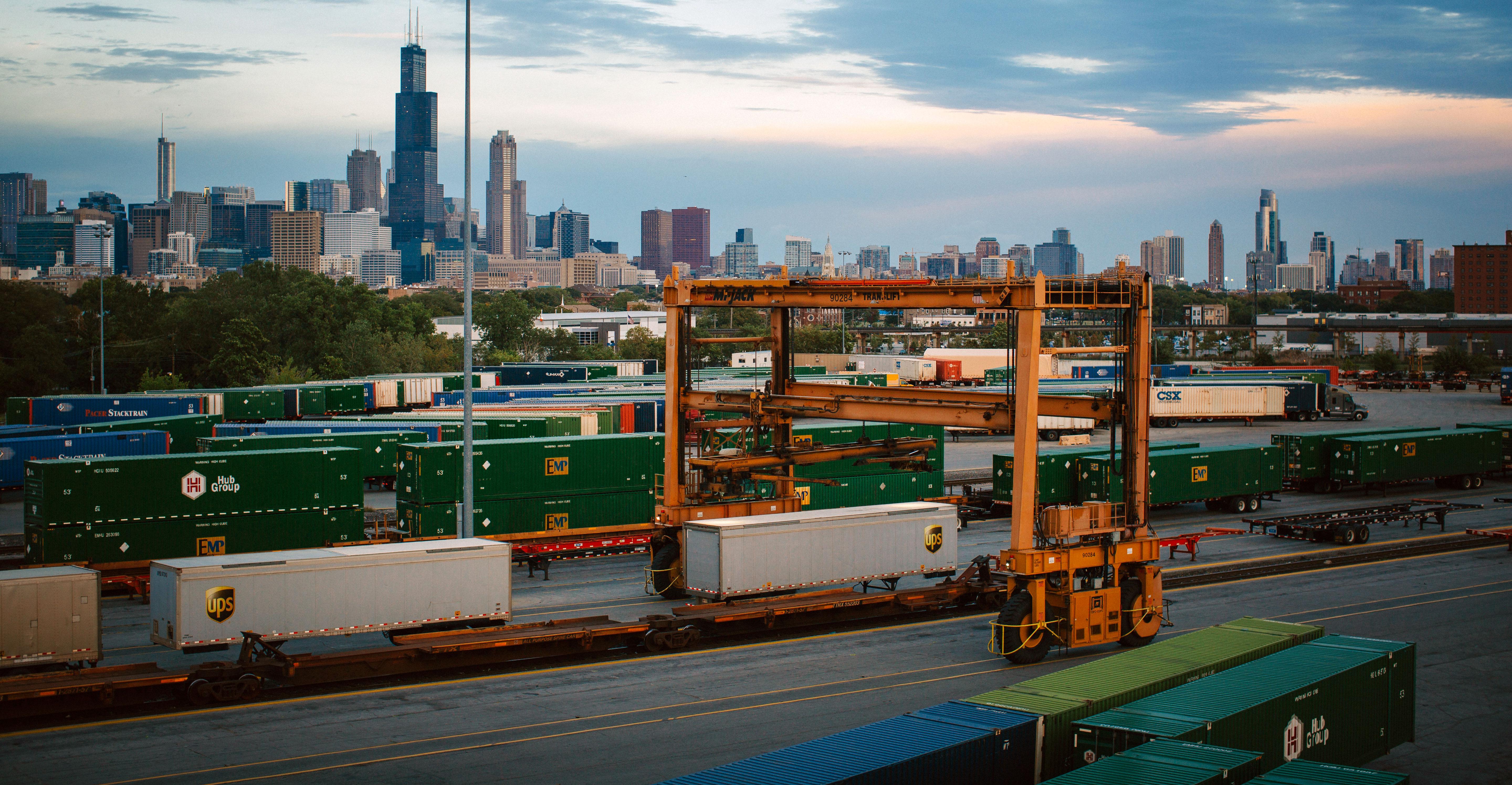
A massive crane loads a container onto a well car in Union Pacific's Proviso terminal.
On the freight side of the operation is the "hump yard." Box cars, tank cars, and cars carrying lumber, steel, coal, crops and automobiles, are pushed up a shallow hill by a remote-controlled locomotive. Then, either individually or in small groups, they are detached by hand and sent rolling down one of several tracks to form new trains. Since the individual cars lack brakes, they are slowed by "retarders" built into sections of track: the source of a squeal that reverberates throughout the yard.
At Global II, enormous mobile cranes – some several stories tall – look like something out of a Star Wars movie. They methodically drive alongside trains of "well" cars, loading and unloading containers. The bottom container sits in a recessed compartment (the "well") so when double-stacked, the train can still fit under bridges. Intermodal containers come in a range of sizes: 20', 40', 45', 48' and 53'. Each intermodal train, then, is a puzzle to assemble where variables of both size and weight must be optimally balanced.
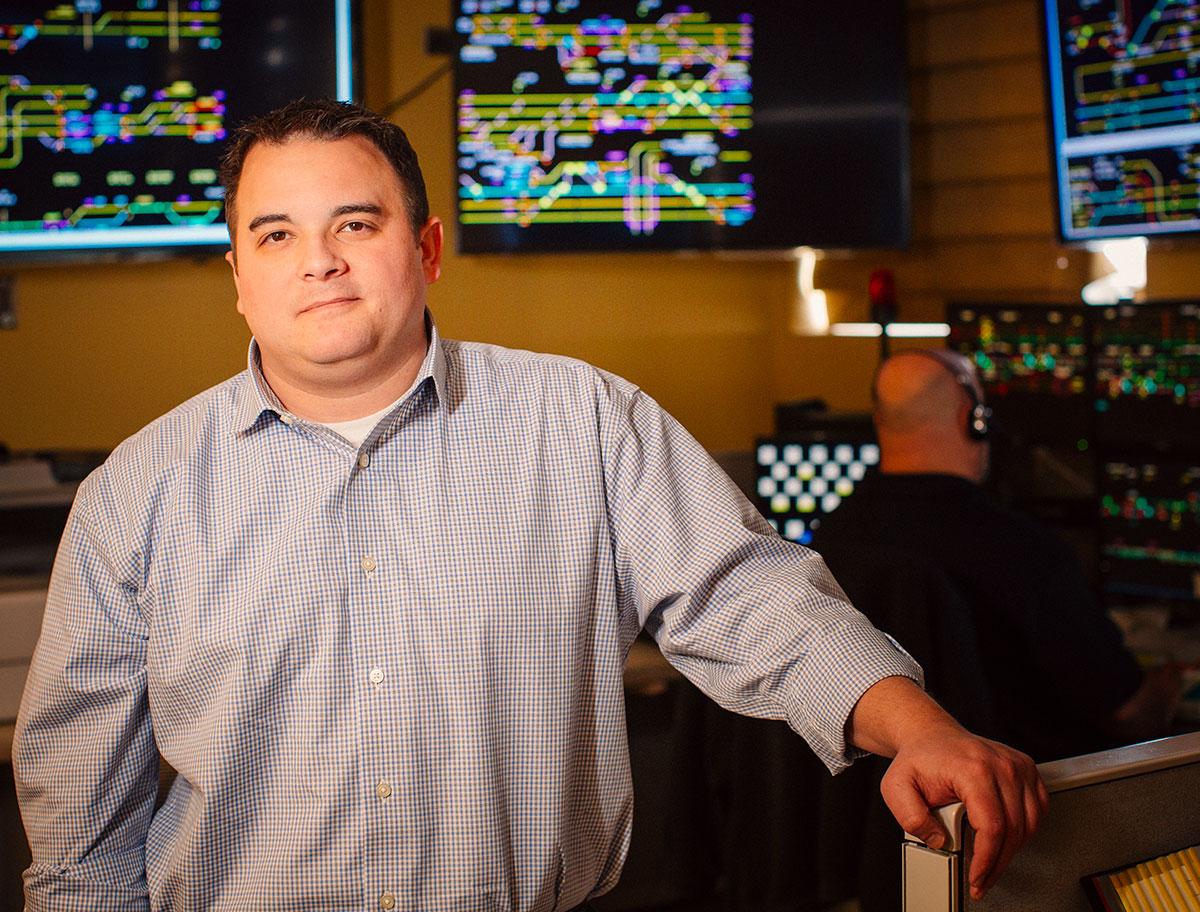
Doug Johnson, Union Pacific director of train management, coordinates train traffic throughout Chicago.
For Doug Johnson, Union Pacific director of train management, the day starts at 3 a.m. when he checks to make sure the last of the night's freight traffic is off the track for the morning Metra rush. Although he won't be in the office for a few hours, running a 24/7 operation means that the work day never ends.
"At the early check-in I'm looking to get an initial outlook for the day," Johnson said. "There are a couple of key trains that depart out of each yard. I'm looking to see if they're on time, and where my inbound trains are. As long as everything's moving, it's a good day."
Delayed and stopped trains are inevitable, though. Everything from flooding in Iowa to the fall harvest can impact traffic at Proviso.
But few challenges compare to the winter of 2014, which brought weeks of subzero temperatures and almost seven feet of snow. The track, particularly switches, had to be cleaned by hand. Johnson, then a terminal manager, joined crews in the thick of it armed with brooms and sledgehammers, battling the Polar Vortex to keep freight and commuters moving. "That's when I knew I was a railroader," he laughs.
The Precision of Commuter Operations
Almost everywhere else in the Chicago Terminal, switch heaters are embedded in the track. From Locomotive Engineer Bruce Prather's perch atop a Metra train headed to Elburn on the West Line, it is easy to spot the tell-tale black control boxes near every switch.
From this vantage point, it is also easier to see the track for what it really is: part of a much larger system that includes signals, mile markers, maintenance signs and rail "greasers" (which squirt lubricant at wheels in advance of curves).
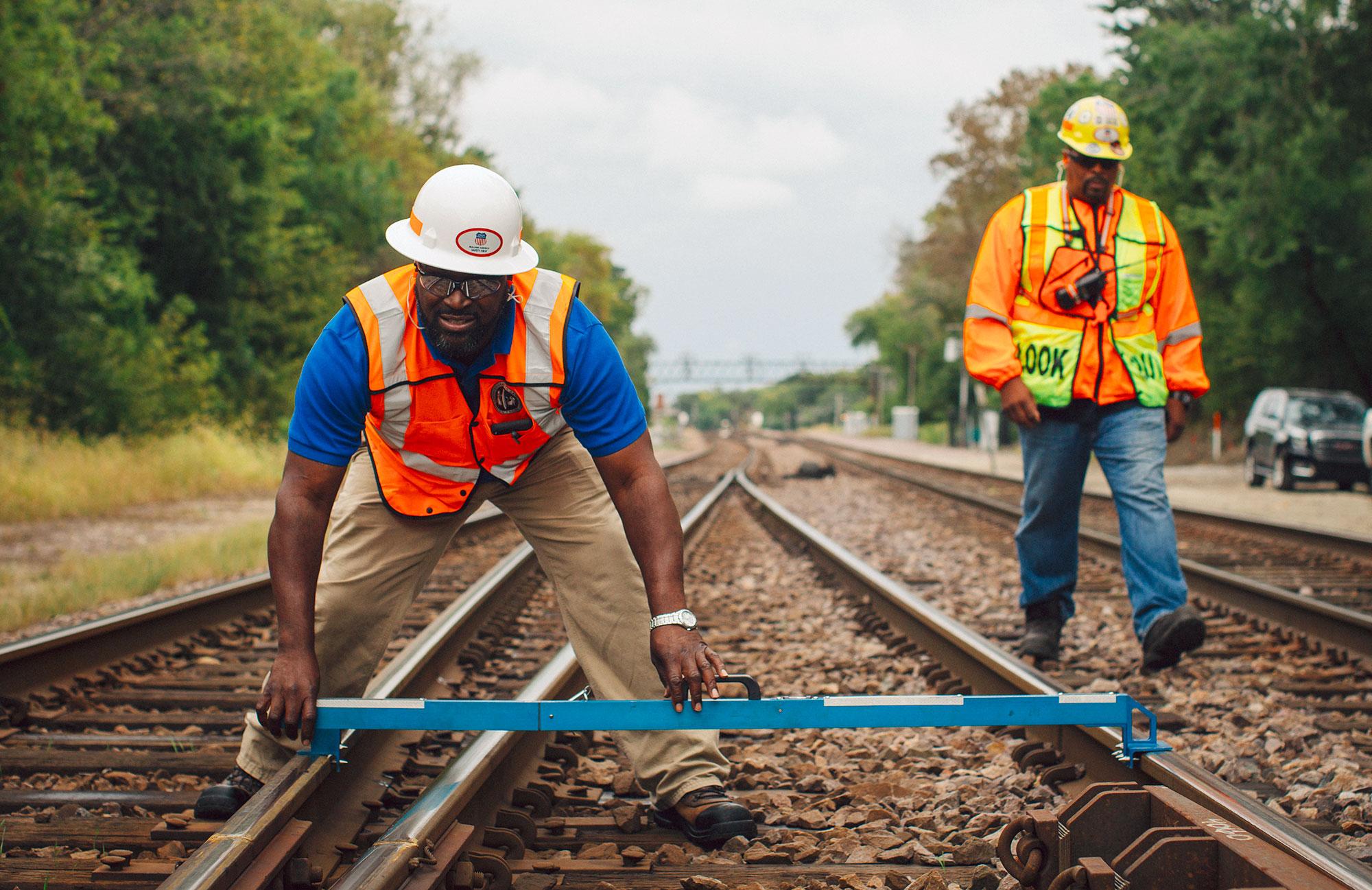
Union Pacific Track Supervisor Demarcus Thompson measures track gauge as Assistant Foreman Truck Driver Jeffrey Smith acts as a lookout to ensure their safety.
It also includes printouts listing "Form B's" — sections where crews will be working — that must be reviewed before each trip. There are whistles and buzzers and the radio chatter of dispatchers, stationmasters and conductors.
A locomotive engineer not only needs to master the intricacies of operating an engine and the logistics of driving a train, but also the details of every stretch of track. Prather, who started in 1969 as a brakeman, knows the West Line perhaps better than anyone.
Using landmarks that he has mentally tagged for cues, Prather knows exactly where to stop at every station along the way, for every length of train and for every configuration of car doors. "For Oak Park, I look for the street sign that says 'Halsted street'," Prather said. "For River Forest it's a telephone pole. I pick out things I know nobody's going to mess with. Sometimes it's even a gutter downspout on a building."
For Prather, pulling into Oligivie Transportation Center (OTC) on the return trip is both a well-honed skill and an art that requires a combination of constant visual triangulation and a deft touch on the brakes to stop precisely on a white line that cannot be seen from his cab.
"I enjoy what I do," Prather said. "Really, I love my job. I get to converse with everybody – the car department, the freight maintenance-of-way and signal guys – really we're all doing the same job."
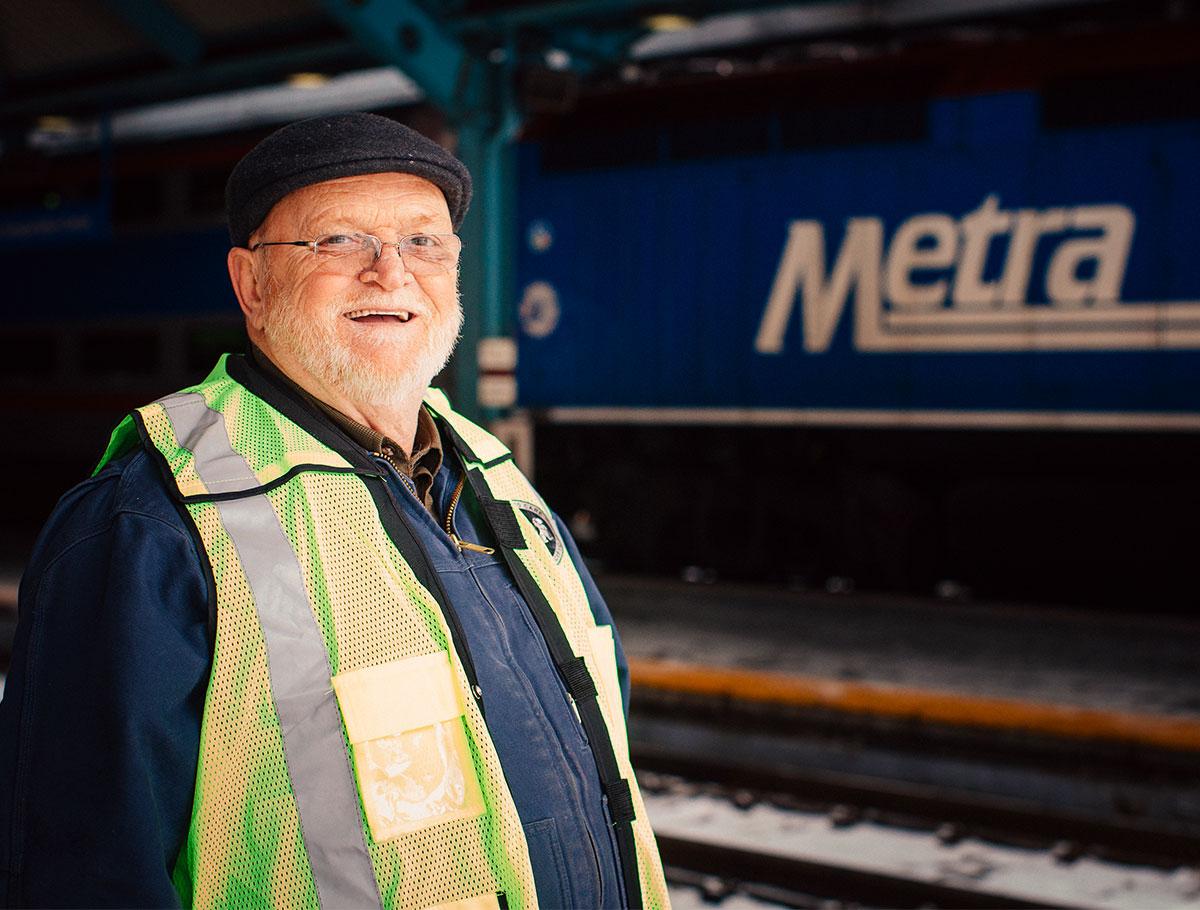
Bruce Prather, Union Pacific locomotive engineer, has been operating freight and commuter locomotives for more than 20 years.
In the forever-twilight beneath the canopy at OTC, the evening rush has begun. Like horses at the gate waiting for the race to begin, the trains are lined up, Metra-blue engines pointing toward destinations: North to Kenosha, Northwest to McHenry or Harvard and West to Elburn. Commuters, tired after a busy day, once more settle in with newspapers, books, laptops and cell phones.
Behind the dark glass of the control room, Union Pacific Stationmaster Loretta Abbott sits in front of a wall of screens, keeping tabs on traffic throughout the terminal. With a flurry of radio messages, calls and faxes, she sends a train on Track 15, whose doors aren't working properly, to the repair yard to be fixed overnight. She assigns a new train and track to take the passengers home and Josh Solomon, one of the "voices of Metra," gets on a microphone to update commuters.
"You have to have patience and great people skills to be good at this job," Abbott said. "I have to know how to multi-task. I keep tabs on everything."
Abbott is charged with ensuring the well-being of passengers, the location of all of the trains – both freight and passenger traffic – all while remaining constantly aware of any mechanical or signal issues that might slow Metra down. "I have to worry about freight traffic all the time," she said. "If there's an issue, I have to figure out a way to run Metra trains around – anything to make sure our passengers arrive safely and on time."
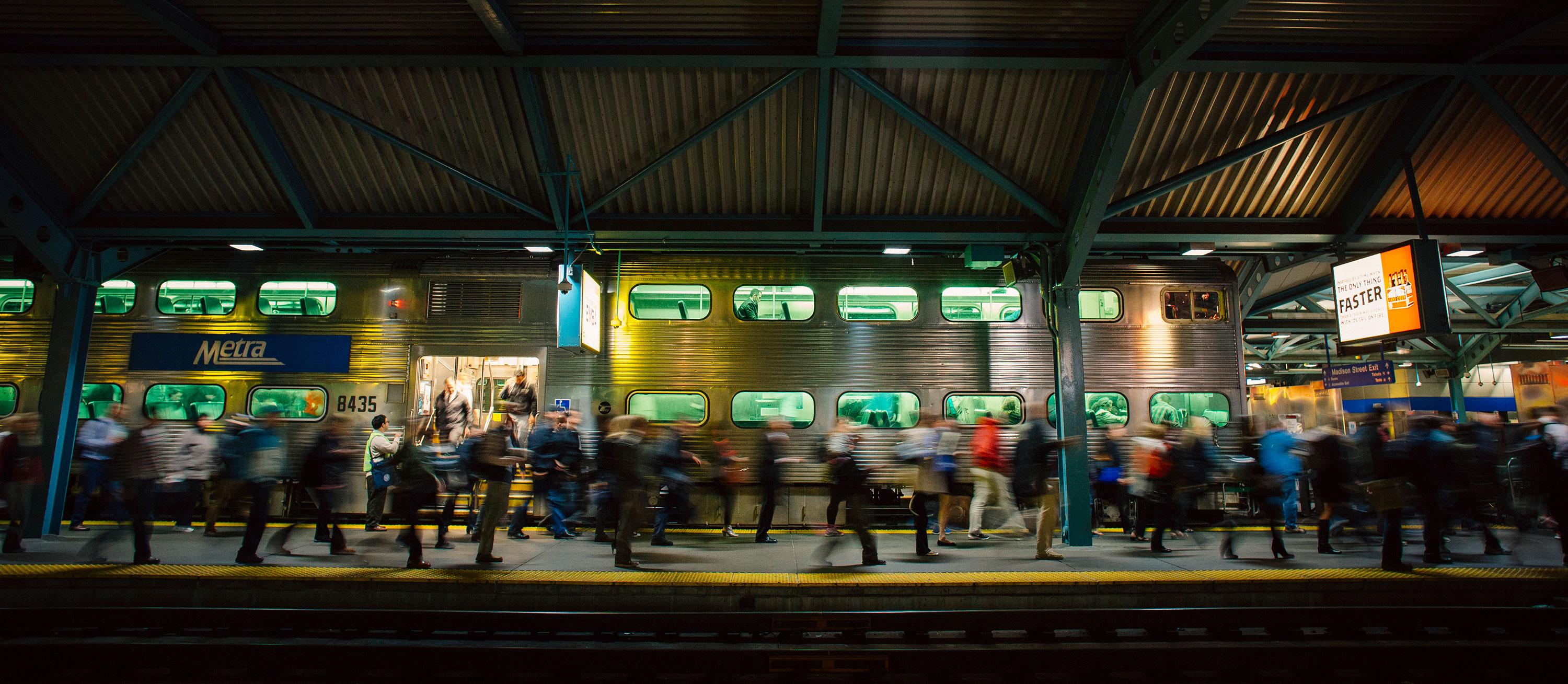
Union Pacific operates about 200 Metra trains per day.
As the recently reassigned North Line train slowly pulls out the station into the rainy dusk, the last thing on the passengers' minds is the on-time performance of their train, a number that is an impressive 95 percent in December 2016. They simply expect the train to arrive in time to be home for dinner.
As the train comes to each stop, commuters pour out, crowding stairways in their hurry home. Their day is ending, but at Proviso — and freight yards throughout the region — the rush has just begun with dozens of trains on the move.
In the Proviso hump yard, pools of light from towering fixtures pierce the darkness as one by one freight cars are sorted onto trains set to embark on cross-country journeys. In the hub that is the Chicago Terminal — the beating heart of North America's rail network — the work never ends.

